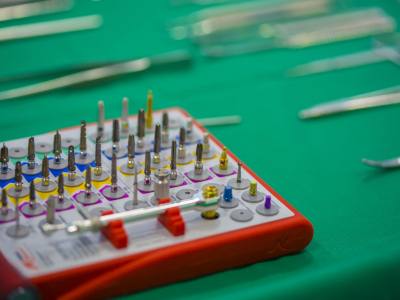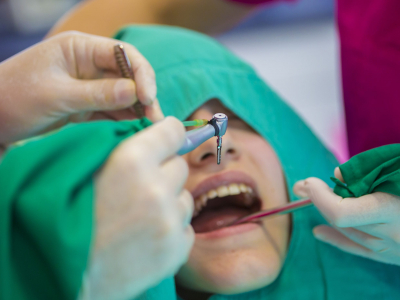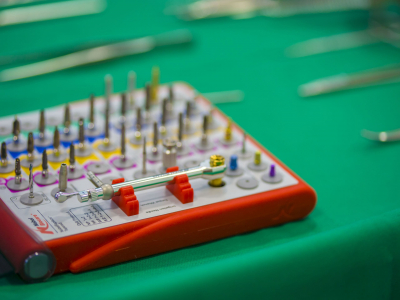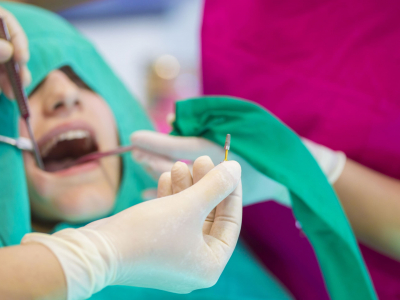At the Primus dental clinic we use CBCT to create a detailed implantology therapy plan for our patients. This enables us to perform a 3D analysis of the bone tissue needed for embedding the implant. We can replace missing bone fragments with different surgical procedures from bone augmentation through sinus lift to bone regeneration using the PRF protocol.
Our clinic uses well-proven high-quality Sky-Bredent and Nobel-Biocare implants. These implants have been shown to be efficient, with a 98 % success rate of implantation. Both implants are biocompatible, which makes the implantation process faster, simpler and most important of all, more comfortable for the patient.
Whether you are missing one of your teeth, several or all of them, our dental implants will make you feel yourself again.
- What is an implant?
- What can you achieve with dental implants?
- Advantages of dental implants over conventional bridges and prosthodontics
- Could you be a candidate for dental implantation?
- What are the potential challenges of successful dental implant therapy?
- What can you expect during the implantation process?
- What can you expect after the implantation?
- What is immediate implantation?
- What is the procedure of replacing missing teeth with implants?
What is an implant?
A state-of-the-art tooth implant is actually a titanium screw which is screwed into and integrated with the jaw bone, which serves as a replacement for the root of the missing tooth. Tooth implants are an ideal option for patients with good oral hygiene, in cases when tooth loss was caused by periodontopathy, unsuccessful dental treatment of the tooth, trauma or other causes. By inserting a tooth implant, we can avoid filing down neighboring teeth, which must be done for building a dental bridge. On the other hand, in cases where all teeth are missing, dental implants offer a permanent solution.
What can you achieve with dental implants?
We can replace one or more missing teeth without having to file down neighboring teeth, as with building dental bridges or when patients must wear dental prosthodontics. Implants can also serve as dental bridge support, which makes the solution more stable and comfortable for wear.
Advantages of dental implants over conventional bridges and prosthodontics
Dental implants are the best solution for tooth replacement from all points of views.
Visual: with dental implants our patient will look and feel exactly as with their original set of teeth. Since the implant will form a strong bond with the jaw bone, this prevents bone loss and gum recession, often occurring in patients with bridges and prosthodontics. What is important: visually, no one will be able to tell if you are wearing dental implants in your mouth.
Caring for your remaining teeth: dental implants are certainly the better option in terms of caring for your remaining teeth. When creating bridges or prosthodontics, filing down some of the nearby teeth is unavoidable. However, we believe that it is important to keep as many of your healthy teeth intact in the interest of long-term oral health.
Comfort and self-confidence: having dental implants will enable you to speak normally, eat with confidence and generally, feel as self-confident and comfortable as with your own set of teeth. There is no uncomfortable rubbing, loosening or feeling of a foreign object in your mouth.
Could you be a candidate for dental implantation?
The short answer is: yes. Basically, everyone can be a candidate for successful implantation. The ideal dental implantation candidate should be generally healthy and have a good oral hygiene. In order to insert the implant, the patient must have a strong enough jaw bone structure so that the implant can bond with the bone.
When do we recommend an implantation?
- when replacing a missing tooth: this is easily done by inserting an implant and capping it with a ceramic crown
- when replacing several missing teeth: if you are missing several teeth, dental implants will serve as anchoring for dental bridges to replace all missing teeth, or so that we can create a comfortable and stable dental prosthodontics
For a successful dental implant treatment, visit our clinic and have a detailed check-up and make your next appointment for implantation.
What are the potential challenges of successful dental implant therapy?
As with every surgery, a small number of diseases and general poor health may have a negative impact on implant and tissue integration. Patients with the following diseases should not be treated with dental implantation: autoimmune diseases, blood clotting disorders, heavy smokers, patients taking bisphosphonates, with tumor diseases, serious cardiovascular diseases, users of immunosuppresants following transplantation, unstable diabetes mellitus, and mental disorders.
Insufficient bone quality can also be a relative counter-indication, in such cases we need to take extra surgical steps by implanting some artificial bone.
What can you expect during the implantation process?
The intervention has a strict protocol, which guarantees that we conserve the bone around the implant and its surrounding tissue. During the procedure we use local anesthesia, it is absolutely pain-free, and we can also use analgosedation in patients who are stressed or fearful of the intervention. The patient will likely experience slight pain in the next 2-3 hours, but this can be treated with painkillers. (e.g. Brufen, Cafetin and Analgin)
What can you expect after the implantation?
Just as your regular teeth require thorough oral hygiene and regular check-ups with the dentist, so do dental implants. You need to brush your teeth (including the implants) just as often, or possibly even more often, and you definitely cannot do without flossing and using a dental shower. After implantation, we will follow up the health status of your replaced teeth, so make sure you schedule regular visits with your dentist.
What is immediate implantation?
Immediate implantation means that the implant is inserted directly after removing the tooth. Sometimes it is not necessary to wait for the wound to heal, so we can start with the implantation immediately, which shortens the overall therapy process.
What is the procedure of replacing missing teeth with implants?
1.Surgical intervention
The standard procedure is: we insert the implants under local anesthesia.
Weighing down on the implant.
When we insert the implants, we achieve a great degree of stability in jaw bone. At this point we can outfit our patients with some or all missing teeth with temporary replacements, crowns or bridges, ready within 24 hours following the implantation. In this way we can visually rehabilitate the patient with missing teeth in the frontal, aesthetically central region or by capping the recently inserted implants with bridges in the case of our patients without any teeth.
2. Opening the implant
Two to three months after the surgical intervention, the implant is revealed and the gingiva former inserted. The aim is to form the gum section so that together with the final prosthodontic replacement it will give the visual impression of real teeth.
3. Prosthodontic rehabilitation
Following the insertion of the gingiva former, we make an impression, which will then be used as the basis for a definitive prosthodontic replacement prepared at the dental lab.
Once the definitive prosthodontic replacement is ready, we will insert it and fix it to the implant.
Good to know: not all cases of teeth loss should be solved by implantation



